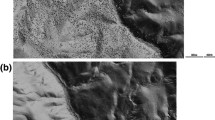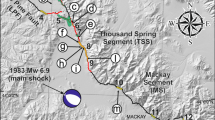Abstract
High-precision and high-resolution topography are the fundamental data for active fault research. Light detection and ranging (LiDAR) presents a new approach to build detailed digital elevation models effectively. We take the Haiyuan fault in Gansu Province as an example of how LiDAR data may be used to improve the study of active faults and the risk assessment of related hazards. In the eastern segment of the Haiyuan fault, the Shaomayin site has been comprehensively investigated in previous research because of its exemplary tectonic topographic features. Based on unprecedented LiDAR data, the horizontal and vertical coseismic offsets at the Shaomayin site are described. The measured horizontal value is about 8.6 m, and the vertical value is about 0.8 m. Using prior dating ages sampled from the same location, we estimate the horizontal slip rate as 4.0 ± 1.0 mm/a with high confidence and define that the lower bound of the vertical slip rate is 0.4 ± 0.1 mm/a since the Holocene. LiDAR data can repeat the measurements of field work on quantifying offsets of tectonic landform features quite well. The offset landforms are visualized on an office computer workstation easily, and specialized software may be used to obtain displacement quantitatively. By combining precious chronological results, the fundamental link between fault activity and large earthquakes is better recognized, as well as the potential risk for future earthquake hazards.









Similar content being viewed by others
References
Lal D (1991) Cosmic ray labeling of erosion surfaces: in situ nuclides production rates and erosion models. Earth Planet Sci Lett 104:424–439
Cockburn HAP, Summerfield MA (2004) Geomorphological applications of cosmogenic isotope analysis. Prog Phys Geog 28:1–42
Gu ZY, Guo ZT, Lal D (2006) 10Be concentration relation to chemical compositions of Chinese loess and red clay as a potential dating method. Quat Sci 26:244–249 (in Chinese)
Kong P, Fabel D, Brown R et al (2007) Cosmic-ray exposure age of Martian meteorite GRV99027. Sci China Ser D-Earth Sci 50:1521–1524
Kong P, Na C, Fink D et al (2007) Cosmogenic 10Be inferred lake-level changes in Sumxi Co basin, Western Tibet. J Asian Earth Sci 29:698–703
Kong P, Na C, Fink D et al (2007) Erosion in northwest Tibet from in situ produced cosmogenic 10Be and 26Al in bedrock. Earth Surf Processes Landf 32:116–125
Ackermann F (1999) Airborne laser scanning-present status and future expectation. Int J Photogramm Remote Sens 54:65–67
Liu JN, Zhang XH (2003) Progress of airborne laser scanning altimetry. Geomat Inf Sci Wuhan Univ 28:132–137 (in Chinese)
Meng X, Wang L, Silvan J et al (2009) A multi-directional ground filtering algorithm for airborne LIDAR. Int J Photogramm Remote Sens 64:117–124
Priestnall G, Jaafar J, Duncan A (2000) Extracting urban features from LiDAR digital surface models computers. Comput Environ Urban 24:65–78
Harding D, Johnson S, Haugerud R (2002) Folding and rupture of an uplifted Holocene marine platform in the Seattle fault zone, Washington, revealed by airborne laser swath mapping. Geol Soc Am Bull 34:107
Haugerud R, Harding D, Johnson S et al (2003) High-resolution LiDAR topography of Puget Lowland Washington—A Bonanza for earth science. Geol Today 13:4–10
Hudnut K, Borsa A, Glennie C et al (2002) High-resolution topography along surface rupture of the 16 October 1999 Hector Mine, California, earthquake (M W7. 1) from airborne laser swath mapping. Bull Seismol Soc Am 92:1570–1576
Prentice CS, Mann P, Crone AJ et al (2010) Tectonic geomorphology and seismic hazard of the Enriquillo-Plantain Garden fault in Haiti. Nat Geosci 3:89–793
Cunningham D, Grebby S, Tansey K et al (2006) Application of airborne LiDAR to mapping seismogenic faults in forested mountainous terrain, southeastern Alps, Slovenia. Geophys Res Lett 33:L20308
Zhou L, Heitaro K, Sakae M et al (2013) Detection of subtle tectonic geomorphic features in densely forested mountains by very high resolution airborne LiDAR survey. Geomorphology 182:104–115
Frankel KL, Dolan JF (2007) Characterizing arid region alluvial fan surface roughness with airborne laser swath mapping digital topographic data. J Geophys Res 112:F02025
Zielke O, Arrowsmith J, Grant LL et al (2010) Slip in the 1857 and earlier large earthquakes along the Carrizo Plain, San Andreas Fault. Science 327:1119–1122
Salisbury JB, Rockwell TK, Middleton TJ et al (2012) LiDAR and field observations of slip distribution for the most recent surface ruptures along the central San Jacinto Fault. Bull Seismol Soc Am 102:598–619
He HL, Wei ZY, Shi F et al (2010) Near-field postseismic deformation along the rupture of 2008 Wenchuan earthquake and its implications. Chin Sci Bull 55:2535–2541
Li DR (2009) Remote Sensing in the Wenchuan Earthquake. Photogramm Eng Remote Sens 75:507–509
Ma HC (2011) Review on applications of LiDAR mapping technology to geosciences. J Chin Univ Geosci 36:347–354 (in Chinese)
Liu J, Chen T, Zhang PZ et al (2013) Illuminating the active Haiyuan fault, China by airborne light detection and ranging. Chin Sci Bull (Chinese Ver) 58:41–45 (in Chinese)
Peltzer G, Tapponnier P (1988) Formation and evolution of strike slip faults, rifts, and basins during the India-Asia collision: an experimental approach. J Geophys Res 93:15085–15117
Burchfiel BC, Zhang PZ, Wang Y et al (1991) Geology of the Haiyuan Fault Zone, Ningxia Autonomous Region, China and its relation to the evolution of the northeastern margin of the Tibetan Plateau. Tectonics 10:1091–1110
Gaudemer Y, Tapponnier P, Meyer B et al (1995) Partitioning of crustal slip between linked, active faults in the eastern Qilian shan, and evidence for a major seismic gap, the “Tianzhu gap”, on the western Haiyuan Fault, Gansu (China). Geophys J Int 120:599–645
Deng QD, Zhang PZ, Chen S (1986) Structure and deformation character of strike slip fault zones. Pure Appl Geophys 124:203–223
Zhang WQ, Jiao DC, Zhang PZ et al (1987) Displacement along the Haiyuan fault associated with the great 1920 Haiyuan, China, earthquake. Bull Seismol Soc Am 77:117–131
Zhang PZ, Molnar P, Burchfiel BC et al (1988) Bounds on the Holocene slip rate of the Haiyuan Fault, north central China. Quat Res 30:151–164
Institute of Geology, China Earthquake Administration and Ninxia Bureau of China Earthquake Administration (1990) Active Haiyuan Fault Zone Monograph, Special Publications on Active Fault Studies in China. Seismological Publishing House, Beijing (in Chinese)
Li CY, Zhang PZ, Yin J et al (2009) Late Quaternary left-lateral slip rate of the Haiyuan fault, northeastern margin of the Tibetan Plateau. Tectonics 28:TC5010
Lasserre C, Morel P, Gaudemr Y et al (1999) Postglacial left slip rate and past occurrence of M ≥ 8 earthquakes on the western Haiyuan fault, Gansu, China. J Geophys Res 104:17633–17652
Lasserre C, Gaudemer Y, Tapponnier P et al (2002) Fast late Pleistocene slip rate on the Leng Long Ling segment of the Haiyuan fault, Qinghai, China. J Geophys Res 107:ETG-4
Wang HY, Gao R, Yin A et al (2012) Deep structure geometry features of Haiyuan Fault and deformation of the crust revealed by deep seismic reflection profiling. Chin J Geophys 12:3902–3909 (in Chinese)
Fan JC, Li SL, Zhang XK et al (2004) Geometric form of Haiyuan fault zone in the crustal interior and dynamics implications. Acta Seism Sin 26:42–49 (in Chinese)
Wang M, Shen ZK, Niu ZJ et al (2003) Contemporary crustal deformation of the Chinese continent and tectonic block mode1. Sci China Ser D-Earth Sci 33:21–32 (in Chinese)
Gan WJ, Cheng PG, Zhou DM et al (2005) Observation of a GPS profile across main faults on northeast margin of Tibetan Plateau and data analysis. Geol Seismol 27:44–57 (in Chinese)
Cavalié O, Lasserre C, Doin M et al (2008) Measurement of interseismic strain across the Haiyuan fault (Gansu, China), by InSAR. Earth Planet Sci Lett 275:246–257
Cui DX, Wang QL, Hu YX et al (2009) Inversion of GPS data for slip rates and locking depths of the Haiyuan fault. Acta Seism Sin 31:516–525 (in Chinese)
Zheng WJ, Zhang PZ, Yuan DY et al (2009) Deformation on the northern of the Tibetan plateau from GPS measurement and geologic rates of late Quaternary along the major fault. Chin J Geophys 52:2491–2508 (in Chinese)
Loveless J, Meade B (2011) Partitioning of localized and diffuse deformation in the Tibetan Plateau from joint inversions of geologic and geodetic observations. Earth Planet Sci Lett 303:11–24
Qu CY, Shan XJ, Song XG et al (2011) The PS InSAR technique and its application to the study on crustal deformation of the Haiyuan fault zone. Chin J Geophys 54:984–993 (in Chinese)
Sieh KE (1978) Pre-historic large earthquakes produced by slip on the San Andreas fault at Pallet Creek, California. J Geophys Res 83:3907–3939
Sieh KE (1984) Lateral offsets and revised dates of large earthquakes at Pallet Creek, California. J Geophys Res 89:7641–7670
Sieh KE, Jahns RH (1984) Holocene activity of the San Andreas Fault at Wallace Creek, California. Geol Soc Am Bull 95:883–896
Schwartz DP, Coppersmith KJ (1984) Fault behavior and characteristic earthquakes: examples from the Wasatch and San Andreas fault zones. J Geophys Res 89:5681–5698
Klinger Y, Etchebes M, Tapponnier P et al (2011) Characteristic slip for five great earthquakes along the Fuyun fault in China. Nat Geosci 4:389–392
Zhang PZ, Li CY, Mao FY (2008) Strath terrace formation and strike-slip faulting. Geol Seismol 30:44–57 (in Chinese)
Acknowledgments
Many thanks to Dr. Chai Chizhang, Dr. Lei Qiyun, and Dr. Du Peng for their help in the field campaigns. We thank the anonymous reviewers for their critical comments and valuable suggestions. This work was funded by the Fundamental Research Funds in the Institute of Geology (IGCEA1125), the Public Service Funds for Earthquake Studies (201308012), the National Natural Science Fund for Distinguished Young Scholars (41225010), and the Foundation of Returned Overseas Scholars of China.
Author information
Authors and Affiliations
Corresponding author
About this article
Cite this article
Chen, T., Zhang, P.Z., Liu, J. et al. Quantitative study of tectonic geomorphology along Haiyuan fault based on airborne LiDAR. Chin. Sci. Bull. 59, 2396–2409 (2014). https://doi.org/10.1007/s11434-014-0199-4
Received:
Accepted:
Published:
Issue Date:
DOI: https://doi.org/10.1007/s11434-014-0199-4




